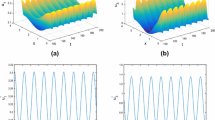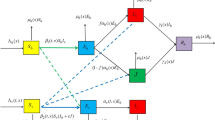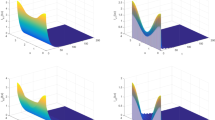Abstract
Malaria is one of the most important parasitic infections in humans and more than two billion people are at risk every year. To understand how the spatial heterogeneity and extrinsic incubation period (EIP) of the parasite within the mosquito affect the dynamics of malaria epidemiology, we propose a nonlocal and time-delayed reaction–diffusion model. We then define the basic reproduction ratio \({\mathcal{R}_0}\) and show that \({\mathcal{R}_0}\) serves as a threshold parameter that predicts whether malaria will spread. Furthermore, a sufficient condition is obtained to guarantee that the disease will stabilize at a positive steady state eventually in the case where all the parameters are spatially independent. Numerically, we show that the use of the spatially averaged system may highly underestimate the malaria risk. The spatially heterogeneous framework in this paper can be used to design the spatial allocation of control resources.
Similar content being viewed by others
References
Aron JL, May RM (1982) The population dynamics of malaria. In: Anderson RM (eds) The population dynamics of infectious diseases: theory and applications. Chapman and Hall, London, pp 139–179
Britton NF (1990) Spatial structures and periodic travelling waves in an integro-differential reaction–diffusion population model. SIAM J Appl Math 50: 1663–1688
Bowman C, Gumel AB, van den Driessche P, Wu J, Zhu H (2005) A mathematical model for assessing control strategies against West Nile virus. Bull Math Biol 67: 1107–1133
Charlwood JD, Smith T, Billingsley PF, Takken W, Lyimo EOK, Meuwissen JHET (1997) Survival and infection probabilities of anthropophagic anophelines from an area of high prevalence of Plasmodium falciparum in humans. Bull Entomol Res 87: 445–453
Chatelin F (1981) The spectral approximation of linear operators with applications to the computation of eigenelements of differential and integral operators. SIAM Rev 23: 495–522
Cosner C, Beier JC, Cantrell RS, Impoinvil D, Kapitanski L, Potts MD, Troyo A, Ruan S (2009) The effects of human movement on the persistence of vector-borne diseases. J Theor Biol 258: 550–560
Freedman HI, Zhao X-Q (1997) Global asymptotics in some quasimonotone reaction–diffusion systems with delays. J Differ Equ 137: 340–362
Gourley SA, Wu JH (2006) Delayed non-local diffusive systems in biological invasion and disease spread. In: Nonlinear dynamics and evolution equations, vol 48. American Mathematical Society, Providence, pp 137–200
Hale J (1988) Asymptotic behavior of dissipative systems. American Mathematical Society, Providence
Hancock PA, Thomas MB, Godfray HCJ (2009) An age-structured model to evaluate the potential of novel malaria-control interventions: a case study of fungal biopesticide sprays. Proc R Soc B 276: 71–80
Heffernan JM, Smith RJ, Wahl LM (2005) Perspectives on the basic reproductive ratio. J R Soc Interface 2: 281–293
Killeen GF, McKenzie FE, Foy BD, Schieffelin C, Billingsley PF, Beier JC (2000) A simplified model for predicting malaria entomologic inoculation rates based on entomologic and parasitologic parameters relevant to control. Am J Trop Med Hyg 62: 535–544
Koella JC (1991) On the use of mathematical models of malaria transmission. Acta Trop 49: 1–25
Li J, Zou X (2009) Modeling spatial spread of infectious diseases with a fixed latent period in a spatially continuous domain. Bull Math Biol 71: 2048–2079
Lou Y, Zhao X-Q (2009) The periodic Ross–Macdonald model with diffusion and advection. Applicable Anal (in press)
Macdonald G (1957) The epidemiology and control of malaria. Oxford University Press, London
Magal P, Zhao X-Q (2005) Global attractors and steady states for uniformly persistent dynamical systems. SIAM J Math Anal 37: 251–275
Martin RH, Smith HL (1990) Abstract functional differential equations and reaction–diffusion systems. Trans Am Math Soc 321: 1–44
Robert V, Macintyre K, Keating J, Trape JF, Duchemin JB, Warren M, Beier JC (2003) Malaria transmission in urban sub-Saharan Africa. Am J Trop Med Hyg 68: 169–176
Ross R (1911) The prevention of malaria, 2nd edn. Murray, London
Ruan S, Xiao D, Beier JC (2008) On the delayed Ross–Macdonald model for malaria transmission. Bull Math Biol 70: 1098–1114
Smith DL, Dushoff J, McKenzie FE (2004) The risk of a mosquito-borne infection in a heterogeneous environment. PLoS Biol 2: 1957–1964
Smith HL (1995) Monotone dynamical systems: an introduction to the theory of competitive and cooperative systems. Amer. Math. Soc. Math. Surveys and Monographs, vol 41
Smith HL, Zhao X-Q (2001) Robust persistence for semidynamical systems. Nonlinear Anal 47: 6169–6179
Snow RW, Guerra CA, Noor AM, Myint HY, Hay SI (2005) The global distribution of clinical episodes of Plasmodium falciparum malaria. Nature 437: 214–217
Tatem AJ, Hay SI, Rogers DJ (2006) Global traffic and disease vector dispersal. Proc Natl Acad Sci USA 103: 6242–6247
Thieme HR (1992) Convergence results and a Poincare–Bendixson trichotomy for asymptotically autonomous differential equations. J Math Biol 30: 755–763
Thieme HR (2009) Spectral bound and reproduction number for infinite-dimensional population structure and time heterogeneity. SIAM J Appl Math 70: 188–211
Thieme HR, Zhao X-Q (2001) A non-local delayed and diffusive predator–prey model. Nonlinear Anal RWA 2: 145–160
Wang W, Zhao X-Q (2009) A nonlocal and time-delayed reaction–diffusion model of dengue transmission (submitted)
Wonham MJ, Lewis MA, Renclawowicz J, van den Driessche P (2006) Transmission assumptions generate conflicting predictions in host-vector disease models: a case study in West Nile virus. Ecol Lett 9: 706–725
Wu J (1996) Theory and applications of partial functional differential equations. Springer, New York
Zhao X-Q (2003) Dynamical systems in population biology. Springer, New York
Author information
Authors and Affiliations
Corresponding author
Additional information
Supported in part by the NSERC of Canada and the MITACS of Canada.
Rights and permissions
About this article
Cite this article
Lou, Y., Zhao, XQ. A reaction–diffusion malaria model with incubation period in the vector population. J. Math. Biol. 62, 543–568 (2011). https://doi.org/10.1007/s00285-010-0346-8
Received:
Revised:
Published:
Issue Date:
DOI: https://doi.org/10.1007/s00285-010-0346-8
Keywords
- Malaria transmission
- Spatial heterogeneity
- Incubation period
- Basic reproduction ratio
- Threshold dynamics
- Global attractivity




